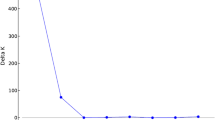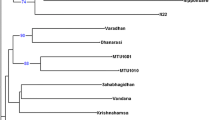Abstract
The objectives of this study were to determine the genetic structure of 242 accessions from the EMBRAPA Rice Core Collection (ERiCC), to create a mini-core collection and to develop a multiplex panel of fluorescent labeled simple sequence repeats (SSRs). Eighty-six SSRs were used to identify 1,066 alleles, with an average number of 12.4 alleles/locus and average polymorphism information content (PIC)/locus of 0.75. A model-based clustering method recognized the structure of the accessions on two levels, according to their cultivation system and origin. The most divergent subgroup identified was the worldwide lowland accessions, with the highest values for gene diversity (0.75), average Rogers distance modified by Wright (0.80), average number of alleles/locus (11.7) and private alleles (132). A mini-core was assembled with the most divergent 24 lowland and upland accessions. This mini-core displayed an average distance of 0.86, an average number of alleles/locus of 8.4 and an average PIC/locus of 0.8. From the 86 SSRs, 24 were selected to compose six multiplex panels in order to optimize the process of rice genotyping. This set of markers distinguished all 242 accessions, and showed an average PIC of 0.80 and an average number of alleles/locus of 15.4, higher than the entire set of 86 SSRs. Since the heterogeneity found in lines and cultivars of ERiCC was higher than expected, it is necessary to analyze pooled DNA samples to get a better estimate of genetic variability. The SSR characterization of ERiCC clearly indicates that there is high genetic variability in rice accessions stored in genebanks worldwide which can be promptly explored by rice pre-breeding programs.




Similar content being viewed by others
References
Abadie T, Cordeiro CMT, Fonseca JR, Alves RBN, Burle ML, Brondani C, Rangel PHN, Castro EM, Silva HT, Freire MS, Zimmermann FJP, Magalhães JRSO (2005) Constructing a rice core collection for Brazil. Pesquisa Agropecu Bras 40:129–136. doi:10.1590/S0100-204X2005000200005
Allard RW (1961) Relationship between genetic diversity and consistency of performance in length environments. Crop Sci 1:127–133
Belkhir K, Borsa P, Chikhi L, Raufaste N, Bonhomme F (2001) Genetix version 4.05.2. http://www.univ-montp2.fr/~genetix/genetix/genetix.htm. Cited 5 may 2004
Borba TCO, Brondani RPV, Rangel PHN, Brondani C (2005) Evaluation of the number and information content of fluorescent-labeled SSR for rice germplasm characterization. Crop Breed Appl Biotechnol 2:157–165
Breseghello F, Sorrels ME (2006) Association analysis as a strategy for improvement of qualitative traits in plants. Crop Sci 46:1323–1330. doi:10.2135/cropsci2005.09-0305
Brondani RPV, Grattapaglia D (2001) Cost-effective method to synthesize a fluorescent internal DNA standard for automated fragment sizing. Biotechniques 31:793–800
Brondani C, Brondani RPV, Rangel PH, Ferreira ME (2001) Development and mapping of Oryza glumaepatula-derived microsatellite markers in the interspecific cross Oryza glumaepatula × O. sativa. Hereditas 134:59–71. doi:10.1111/j.1601-5223.2001.00059.x
Brondani C, Rangel PHN, Brondani RPV, Ferreira ME (2002) QTL mapping and introgression of yield related traits from Oryza glumaepatula to cultivated rice (Oryza sativa) using microsatellite markers. Theor Appl Genet 104:1192–1203. doi:10.1007/s00122-002-0869-5
Brondani C, Borba TCO, Rangel PHN, Brondani RPV (2006) Determination of traditional varieties of Brazilian rice using microsatellite markers. Genet Mol Biol 29:676–684. doi:10.1590/S1415-47572006000400017
Brown AHD (1989) Core collections: a practical approach to genetic resources management. Genome 31:818–824
Cho YG, Ishii T, Temnykh S, Chen X, Lipovich L, McCouch SR, Park WD, Ayres N, Cartinhour S (2000) Diversity of microsatellites derived from genomic libraries and genbank sequences in rice (Oryza sativa L.). Theor Appl Genet 100:713–722. doi:10.1007/s001220051343
Cruz CD (1997) Programa genes: aplicativo computacional em genética e estatística. UFV, Viçosa
Frankel OH (1984) Genetic perspectives of germplasm conservation. In: Arber W, Llimensee K, Peacock WJ, Starlinger P (eds) Genetic manipulation: impact on man and society. Cambridge University Press, Cambridge, pp 161–170
Gao LZ, Zhang CH, Chang LP, Jia JZ, Qiu ZE, Dong YS (2005) Microsatellite diversity within Oryza sativa with emphasis on indica-japonica divergence. Genet Res 85:1–14. doi:10.1017/S0016672304007293
Garris AJ, Tai TH, Coburn J, Kresovich S, McCouch SR (2005) Genetic structure and diversity in Oryza sativa L. Genetics 169:1631–1638. doi:10.1534/genetics.104.035642
Hamilton RS, Raymond R (2005) Toward a global strategy for the conservation of rice genetic resources. In: Toriyama K, Heong KL, Hardy B (ed) Rice is life: scientific perspectives for the 21st century. Proceedings of the World Rice Research Conference held in Tsukuba, Japan, CD-ROM, pp 47–49
Hossain M (2007) Rice facts: a balancing act. Rice Today 6:37
Jain S, Jain RK, McCouch SR (2004) Genetic analysis of Indian aromatic and quality rice (Oryza sativa L.) germplasm using panels of fluorescently-labeled microsatellite markers. Theor Appl Genet 109:965–977. doi:10.1007/s00122-004-1700-2
Khush GS (1997) Origin, dispersal, cultivation and variation of rice. Plant Mol Biol 35:25–34. doi:10.1023/A:1005810616885
Lewis PO, Zaykin D (2001) Genetic data analysis: computer program for the analysis of allelic data version 1.0. http://lewis.eeb.uconn.edu/lewishome/software.html. Cited 21 Nov 2001
Liu K, Muse SV (2005) Powermarker: an integrated analysis environment for genetic marker analysis. Bioinformatics 21:2128–2129. doi:10.1093/bioinformatics/bti282
Lu H, Redus MA, Coburn JR, Rutger JN, McCouch SR, Tai TH (2005) Population structure and breeding patterns of 145 US rice cultivars based on SSR marker analysis. Crop Sci 45:66–76
Ni J, Colowit PM, Mackill D (2002) Evaluation of genetic diversity in rice using microsatellite markers. Crop Sci 42:601–607
Perrier X, Flori A, Bonnot F (2003) Data analysis methods. In: Hamon P, Seguin M, Perrier X, Glaszmann JC (eds) Genetic diversity of cultivated tropical plants. Science Publishers, Montpellier, pp 43–76
Pritchard JK, Stephens M, Donnelly P (2000) Inference of population structure using multilocus genotype data. Genetics 155:945–959
Rangel PN (2008) Utilização da espécie silvestre Oryza glumaepatula como doadora de alelos para aumento da produção e da tolerância à seca do arroz (Oryza sativa) via análise de AB-QTLs. Thesis, Universidade Federal de Goiás
Rangel PHN, Guimarães EP, Neves PCF (1996) Base genética das cultivares de arroz (Oryza sativa L.) irrigado do Brasil. Pesquisa Agropecu Bras 31:349–357
Ravi M, Geethanjali S, Sameeyafarheen F, Maheswaran M (2003) Molecular marker based genetic diversity analysis in rice (Oryza sativa L.) using RAPD and SSR. Euphytica 133:243–252. doi:10.1023/A:1025513111279
Rohlf FJ (1989) NTSYSpc. Version 2.02g
Sefc KM, Steinkellner H, Wagner HW, Glössl J, Regner F (1997) Application of microsatellite markers to parentage studies in grapevine. Vitis 36:179–183
Tanksley S, McCouch SR (1997) Seed banks and molecular maps: unlocking genetic potential from the wild. Science 277:1063–1066. doi:10.1126/science.277.5329.1063
Thomson MJ, Septiningsih EM, Suwardjo F, Santoso TJ, Silitonga TS, McCouch SR (2007) Genetic diversity analysis of traditional and improved Indonesian rice (Oryza sativa L.) germplasm using microsatellite markers. Theor Appl Genet 114:559–568. doi:10.1007/s00122-006-0457-1
Tyagi A, Khurana JP, Khurana P, Raghuvanshi S, Gaur A, Kapur A, Gupta V, Kumar D, Ravi V, Vij S, Khurana P, Sharma S (2004) Structural and functional analysis of rice genome. J Genet 83:79–99. doi:10.1007/BF02715832
Upadhyaya HD, Gowda CLL, Buhariwalla HK, Crouch JH (2006) Efficient use of crop germplasm resources: identifying useful germplasm for crop improvement through core and mini-core collections and molecular marker approaches. Plant Genet Resour; Characterization Util 4:25–35. doi:10.1079/PGR2006107
Valone MP, Butler JM (2004) AutoDimer: a screening tool for primer-dimer and hairpin structures. Biotechniques 37:226–231
van Hintum TJLV, Brown AHD, Spillane C, Hodgkin T (2000) Core collections of plant genetic resources. IPGRI, Roma, 48 pp
Wright S (1978) Evolution and the genetics of populations, vol 4. Variability within and among natural populations, U. Chicago Press Chicago
Xu YB, Beachell H, McCouch SR (2004) A marker-based approach to broadening the genetic base of rice in the USA. Crop Sci 44:1947–1959
Acknowledgments
We gratefully acknowledge the Ph.D. scholarship to Tereza Borba and the financial support from CNPq (Conselho Nacional de Desenvolvimento Científico e Tecnológico—National Council of Technological and Scientific Development).
Author information
Authors and Affiliations
Corresponding author
Electronic supplementary material
Below is the link to the electronic supplementary material.
Rights and permissions
About this article
Cite this article
de Oliveira Borba, T.C., Brondani, R.P.V., Rangel, P.H.N. et al. Microsatellite marker-mediated analysis of the EMBRAPA Rice Core Collection genetic diversity. Genetica 137, 293–304 (2009). https://doi.org/10.1007/s10709-009-9380-0
Received:
Accepted:
Published:
Issue Date:
DOI: https://doi.org/10.1007/s10709-009-9380-0




